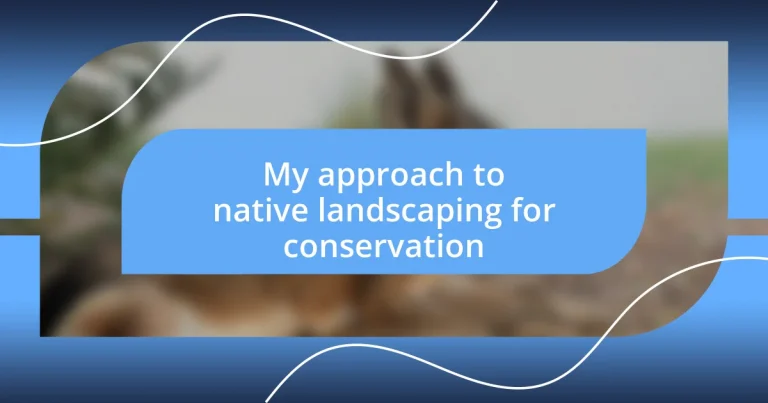Key takeaways:
- Native landscaping enhances biodiversity by using local plants, which require less maintenance and attract wildlife.
- Designing native landscapes involves understanding local conditions and creating diverse plant communities that reflect natural ecosystems.
- Ongoing maintenance and evaluation are essential for sustaining native landscapes, including recognizing invasives and tracking wildlife diversity and soil health.
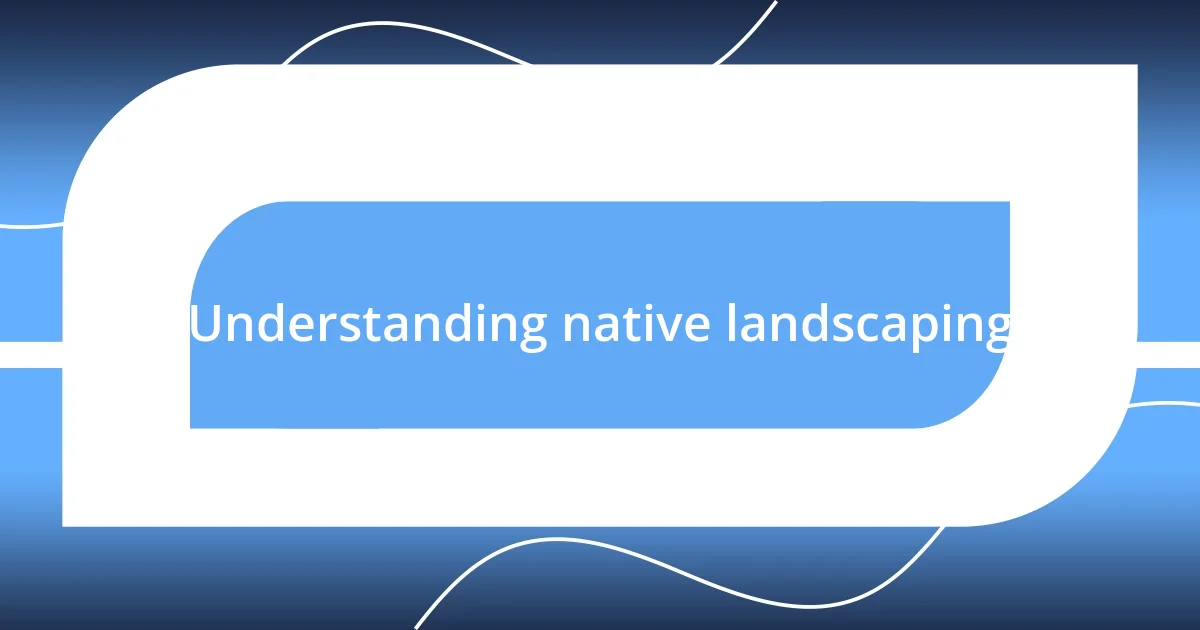
Understanding native landscaping
Native landscaping is all about working with nature rather than against it. I remember the first time I planted a native garden; it felt like I was reconnecting with the land. There’s something incredibly rewarding about watching local plants thrive, feeling a sense of pride in nurturing what’s already adapted to our environment.
Have you ever considered how much easier it is to maintain plants that belong to the area? When I transitioned to native plants, I found that they not only required less water but also attracted an incredible variety of local wildlife. The chorus of birds, bugs, and butterflies became a vibrant testament to the power of using plants that naturally coexist with each other and the ecosystem.
As I dug deeper into understanding native landscaping, I discovered how essential it is for conservation efforts. It’s astonishing to think that by choosing local species, I’m not just beautifying my space but also playing a small part in preserving biodiversity. Isn’t it fascinating to realize that we, too, can be stewards of the places we call home?
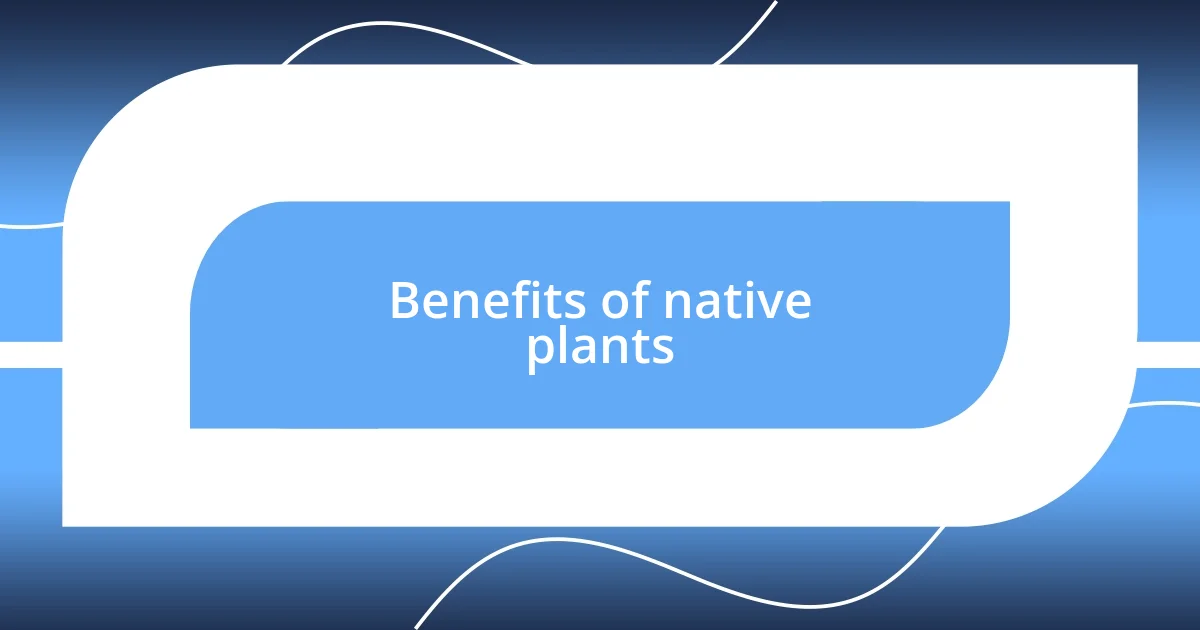
Benefits of native plants
Choosing native plants comes with a plethora of benefits that I’ve come to appreciate over the years. For one, these plants are tailored to thrive in local soil and climate conditions, which means less watering and fertilizer for me! The first summer I replaced my exotic plants with natives, I was amazed at how vibrant my garden looked with much less effort on my part.
Beyond the aesthetics, native plants encourage wildlife presence. I vividly recall the day a family of rabbits made a home in my garden, nestled among the native grasses I had planted. It was a delightful reminder of how these plants provide essential habitat and food sources for local fauna, creating a balanced ecosystem right in my backyard.
Moreover, using native species helps in combating invasive plants. I’ve personally witnessed the overwhelming spread of non-natives in my community, and it’s disheartening to see the local flora and fauna suffer as a result. By prioritizing native plants, we can restore our local ecosystems, allowing the land to thrive once again. The more I learn, the clearer it becomes: every plant I choose can either enhance or hinder the environment.
| Benefits | Description |
|---|---|
| Water Efficiency | Native plants require significantly less water than non-native species, making them a sustainable choice. |
| Wildlife Support | They provide habitat and food for local wildlife, encouraging biodiversity in your garden. |
| Reduced Maintenance | Once established, native plants often require less care, reducing time spent on upkeep. |
| Soil Health | They improve soil health through their deep root systems, which help prevent erosion. |
| Invasion Prevention | Using native species prevents non-natives from dominating the ecosystem, promoting balance. |
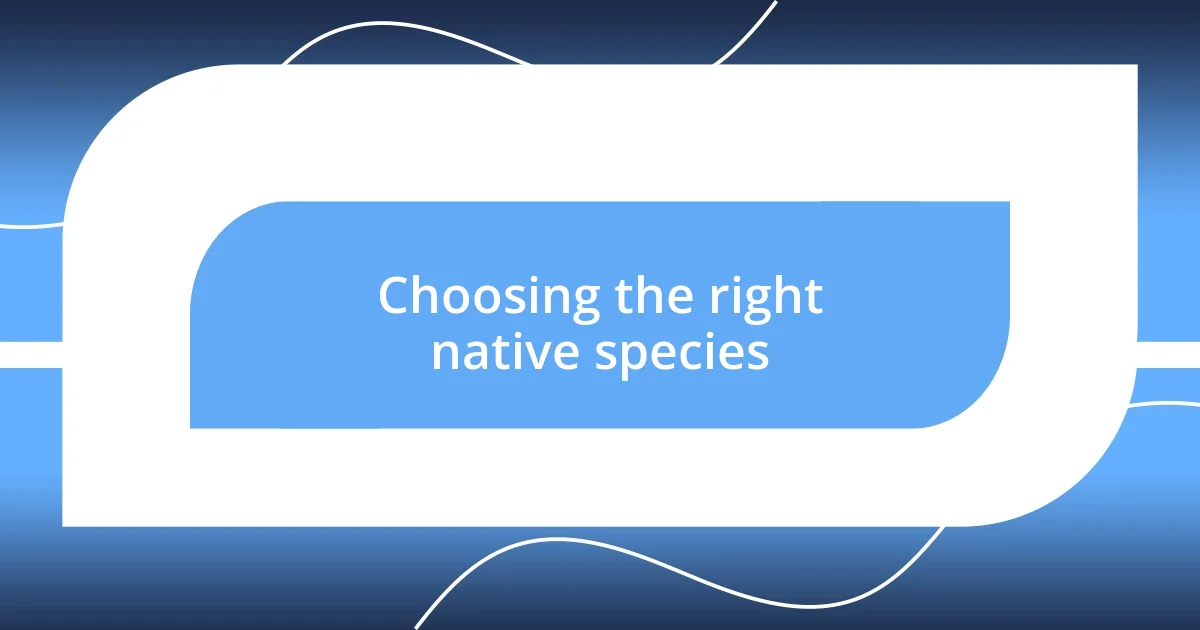
Choosing the right native species
When selecting the right native species, it’s crucial to consider the specific conditions of your site. I remember standing in my garden, overwhelmed by the choices, yet realizing I needed to match plant selections with sun exposure, soil type, and local climate. This realization truly transformed how I approached landscaping. The more suitable the species, the more likely they will flourish and contribute positively to the environment around them.
Here’s a quick checklist that has helped me in this process:
- Assess your environment: Check sunlight, soil moisture, and drainage in your yard.
- Research local species: Use local garden centers or extension services for guidance on plants suited to your area.
- Consider plant community: Mix species that naturally grow together to create a harmonious ecosystem.
- Think about growth patterns: Choose plants with varying heights and bloom times for year-round interest.
- Source sustainably: Aim to purchase plants from local nurseries that propagate them in an environmentally friendly manner.
Each of these steps can make a meaningful difference in creating a thriving native landscape that not only beautifies your space but also fosters a sense of community in nature.

Designing a native landscape
Designing a native landscape is a fascinating journey that begins with understanding the space you have. I often find myself surveying my yard, taking note of the sun-drenched corners versus the shaded nooks. This awareness has guided my choices and made the whole process feel like a dialogue with the land itself. Have you ever noticed how the right plant in the right spot can transform a space? This realization can be the spark that ignites your native landscaping project.
When I design my native landscape, I like to think about layers—how plants will interact with each other as they grow. Incorporating a mix of heights and textures has proven incredibly rewarding. One year, I added some low-lying ground covers beneath taller flowering plants, and it was as if my garden had found its very own rhythm. The delicate blooms complemented the sturdy structures above, creating a harmonious dance of color and life. Each interaction tells a story, and as I watch this unfold, I can’t help but wonder: what stories will your plants tell?
Another aspect I cherish is creating zones that reflect different habitats. For instance, my little wetland section, complete with marsh grasses and flowering plants, has drawn in all sorts of wildlife. A family of frogs took up residence, and their evening chorus is a soothing reminder of the beauty I’ve nurtured. It makes me think—what types of zones could you create to invite nature into your own design? Understanding these dynamics has not only led to an eye-catching landscape but also fostered deeper connections with the wildlife around me.
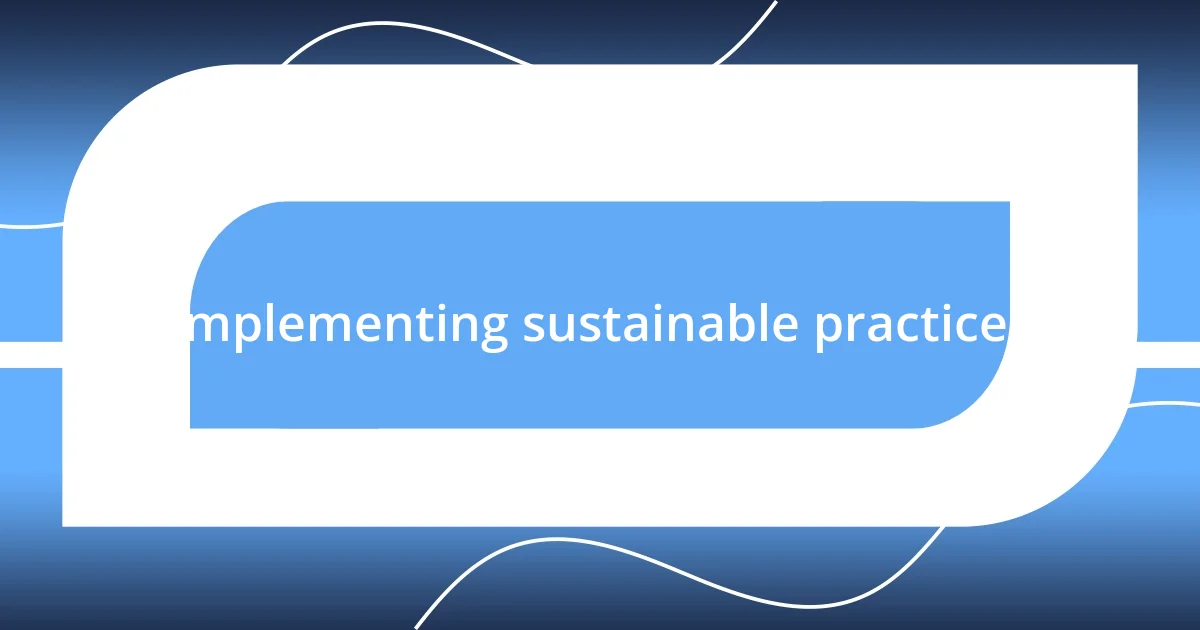
Implementing sustainable practices
Implementing sustainable practices in native landscaping is like weaving a tapestry of life right in your backyard. I found that embracing rain gardens has been one of my most fulfilling choices. By directing runoff into these gardens filled with native plants, I’ve not only reduced erosion but also created a vibrant space buzzing with pollinators. Have you ever noticed how quickly nature responds when treated with respect? The lush beauty that followed my rain garden installation still amazes me.
Another practice that has made a significant impact is reducing the use of synthetic fertilizers and pesticides. I remember the first summer after I transitioned to completely organic options; it was both nerve-wracking and exhilarating. Watching ladybugs and butterflies return confirmed my decision. It’s incredible how nurturing the natural predatory insects can keep pest populations in check while creating a healthier ecosystem. Have you considered how your choices in gardening products can ripple through your entire landscape?
Finally, I make it a habit to continuously educate myself on sustainable practices. Attending local workshops has opened my eyes to various approaches, from composting scraps to using organic mulch. I realized there’s a community of passionate gardeners eager to share their successes and challenges. Engaging with others helps me stay motivated while reinforcing the idea that conservation is a shared journey. How do you connect with your gardening community? I’ve found that exchanging ideas often leads to innovative solutions that benefit our shared environment.
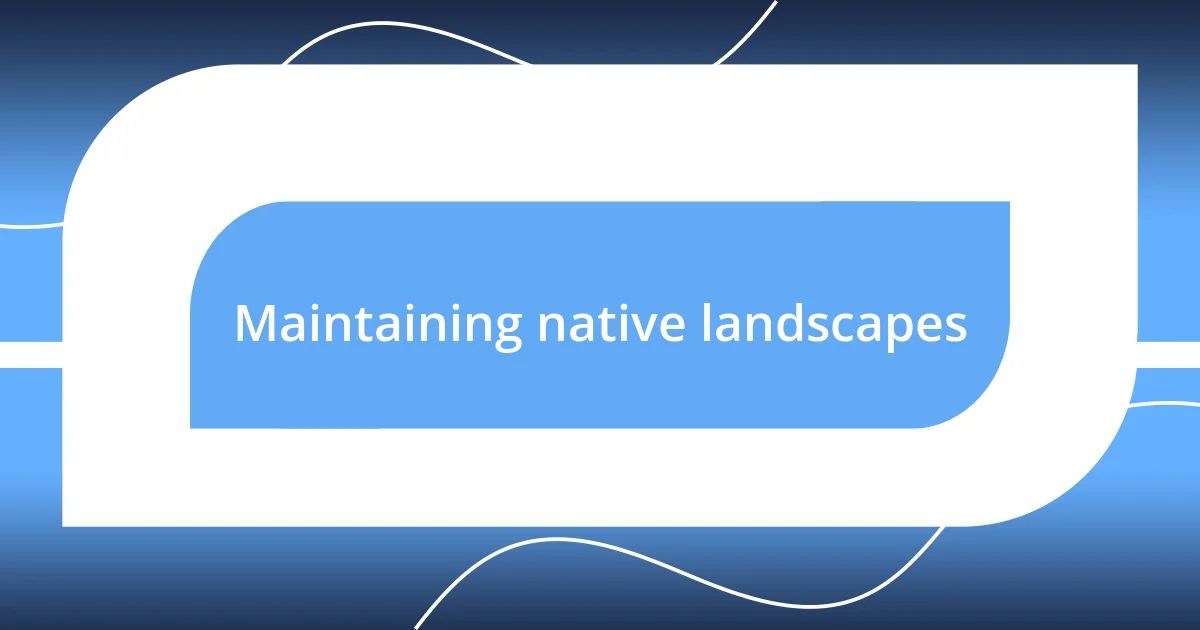
Maintaining native landscapes
Maintaining a native landscape is more than just occasional watering or weeding; it’s an ongoing relationship with the land. I remember the thrill I felt during my first spring after planting. Each day, I would excitedly check for new sprouts and blossoms, like greeting old friends returning for a reunion. This connection transforms maintenance into a delightful routine, where I celebrate each small victory, and I often ask myself: how can I nurture these plants even more?
I’ve learned that a key part of upkeep involves understanding seasonal changes. For example, in the autumn, I love to leave some seed heads intact for winter birds. It’s both practical and rewarding to witness them flitting around, feasting on the very plants I cultivated. This simple act of intentionality not only supports the ecosystem but also imbues my garden with life, reminding me to consider how my choices ripple out into the natural world.
There’s also the art of recognizing invasive species. I recall a time when I spotted a handful of them creeping into my landscape, trying to outshine my beloved natives. My heart raced as I yanked them out, feeling like a guardian of my garden. It’s a reminder that even as we strive for conservation, vigilant attention is necessary to keep the balance. How do you ensure your native landscape remains a sanctuary? Sometimes, it’s about being in tune with what the garden needs, which can be an incredibly fulfilling part of the journey.
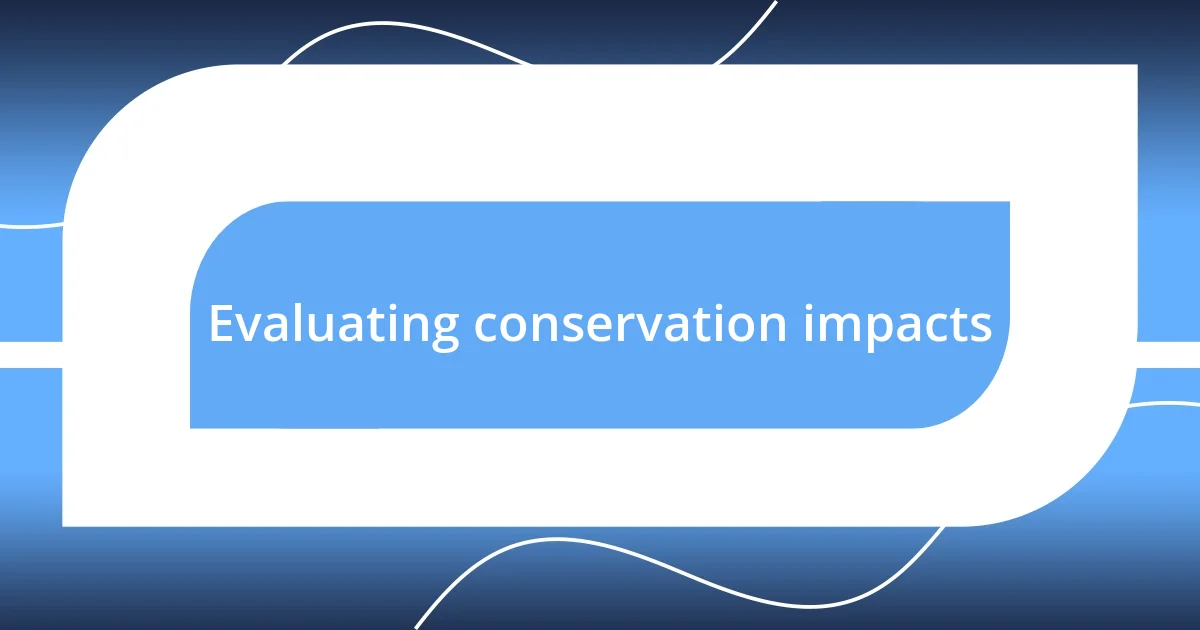
Evaluating conservation impacts
Evaluating conservation impacts is crucial in understanding the effectiveness of our landscaping choices. In my experience, I’ve taken to measuring the diversity of wildlife visiting my garden. One afternoon, I found myself counting six different butterfly species flitting about, and I felt a rush of joy—this wasn’t just a hobby; it was evidence that my efforts were paying off. It prompts me to ask: what signs do you look for to gauge your landscape’s health?
Another aspect I focus on is soil health, which often correlates directly with the success of native plants. I recall a particularly enlightening workshop where I learned to conduct simple soil tests. It was surprising how rich and alive my soil had become after years of following sustainable practices. How aware are you of the life lurking beneath the surface of your garden? By staying vigilant, I noticed healthier plants emerging, reflecting the thriving ecosystem I aimed to create.
Lastly, I find that keeping records of these evaluations not only helps track progress but also allows me to set future goals. I’ve started a garden journal where I jot down my observations. When I flipped through those pages recently, I was amazed at the transformation over the seasons—not just of my garden, but of my understanding as a steward of the land. Are you documenting your journey too? Capturing these moments can illuminate not just the impacts we’ve made, but also guide our future conservation efforts.












